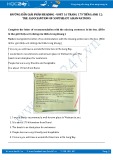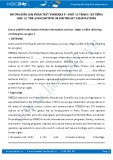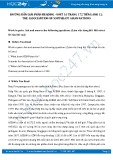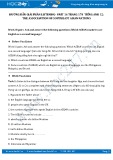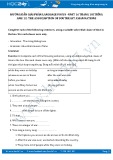
1
LƢU NGỌC LAN
Lƣ
Tổng hợp
21 CHUYÊN ĐỀ NGỮ PHÁP
học sinh THPT cần nắm vững
(phù hợp cho học sinh ôn thi học kì hoặc
ôn thi vào đại học)

3
MỤC LỤC
CONTENTS
THƯ GỬI ĐẾN CÁC EM HỌC SINH. .................................................................................................... 1
VỀ GIÁO VIÊN ................................................................................................................................... 4
CHUYÊN ĐÈ 1: CÁC THÌ HIỆN TẠI ....................................................................................................... 5
CHUYÊN ĐỀ 2: CÁC THI QUÁ KHỨ ..................................................................................................... 8
CHUYÊN ĐỀ 3: CÁC THÌ TƯƠNG LAI ................................................................................................ 18
CHUYÊN ĐỀ 4: SỰ HÒA HỢP GIỮA CÁC THỜI (THE SEQUENCE OF TENSES) ...................................... 22
CHUYÊN ĐỀ 5: ĐỘNG TỪ KHUYẾT THIẾU (MODAL VERBS) ............................................................... 25
CHUYÊN ĐỀ 6: CÂU ĐIỀU KIỆN VÀ CÂU ƯỚC ................................................................................... 29
(CONDITIONAL SENTENCES AND WISHES) ...................................................................................... 29
CHUYÊN ĐỀ 7: CÂU BỊ ĐỘNG .......................................................................................................... 33
(PASSIVE SENTENCES) ........................................................................................................................... 33
CHUYÊN ĐỀ 8: CÂU TƯỜNG THUẬT ................................................................................................ 41
CHUYÊN ĐỀ 9: INFINITVES AND GERUNDS (TO V VÀ V-ING) ........................................................... 48
CHUYÊN ĐỀ 10: GERUND AND PRESENT PARTICIPLE ....................................................................... 51
(DANH ĐỘNG TỪ VÀ HIỆN TẠI PHÂN TỪ) ............................................................................................ 51
CHUYÊN ĐỀ 11: SỰ SO SÁNH .......................................................................................................... 54
CHUYÊN ĐỀ 12: MỆNH ĐỀ QUAN HỆ ............................................................................................... 58
CHUYÊN ĐỀ 13: SỰ ĐẢO NGỮ (INVERSION) .................................................................................... 61
CHUYÊN ĐỀ 14: CÁC MỆNH ĐỀ VÀ CỤM TỪ .................................................................................... 66
CHUYÊN ĐỀ 15: SENTENCE CONNECTORS ....................................................................................... 74
CHUYÊN ĐỀ 16: CÂU HỎI ĐUÔI- TAG QUESTIONS ........................................................................... 77
CHUYÊN ĐỀ 17: SUBJECT – VERBS AGREEMENT .............................................................................. 81
CHUYÊN ĐỀ 18 : TỪ HẠN ĐỊNH ( DETERMINERS) ............................................................................. 85
CHUYÊN ĐỀ 19: ARTICLES (MẠO TỪ) .............................................................................................. 88
CHUYÊN ĐỀ 20: PREPOSITIONS (GIỚI TỪ) ....................................................................................... 93
CHUYÊN ĐỀ 21: SUBJUNTIVE (GIẢ ĐỊNH) ........................................................................................ 99

5
CHUYÊN ĐÈ 1: CÁC THÌ HIỆN TẠI
I. HIỆN TẠI ĐƠN (PRESENT SIMPLE):
1. Cách thành lập:
2. Cách dùng chính:
Thì hiện tại đơn diễn tả:
- Một thói quen hoặc một hành động lặp đi lặp lại. Trong câu thường có các trạng từ: always, often,
usually, sometimes, seldom, rarely, every day/week/month…
o Eg: Mary often gets up early in the morning.
(Mary thƣờng dậy sớm vào buổi sáng.)
- Một sự thật hiển nhiên, một chân lí.
o Eg: The sun rises in the east and sets in the west.
(Mặt trời mọc ở hƣớng đông và lặn ở hƣớng tây.)
- Một thời gian biểu tình hoặc một lịch trình.
o Eg: The last train leaves at 4.45.
(Chuyến tàu cuối cùng rời lúc 4.45.)
II. HIỆN TẠI TIẾP DIỄN (PRESENT PROGRESSIVE)
1. Cách thành lập:
2. Cách dùng:
Thì hiện tại tiếp diễn dùng để diễn tả:
- Một hành động đang xảy ra tại thời điểm nói, trong câu thường có các trạng từ: now, right now, at the
moment, at present, …
o Eg: What are you doing at the moment? (Bạn đang làm gì đấy?)
I‘m writing a letter.(Mình đang viết thƣ.)
Be quiet! My mother is sleeping (Yên lặng nào! Mẹ mình đang ngủ.)
- Một hành động đã được lên kế hoạch từ trước.
o Eg: What are you doing tonight?(Tối nay cậu định làm gì?)
I am going to cinema with my father.(Tớ định đi cùng bố đến rạp chiếu phim.)
- Một hành động nhất thời (dùng để chỉ sự thay đổi) today, this week, this month, these days, …
- Câu khẳng định
- Câu phủ định
- Câu nghi vấn
S + V(s/es);
S + do/does + not + V;
Do/does + S + V?;
S + am/is/are
S + am/is/are + not
Am/Is/Are + S?
- Câu khẳng định
- Câu phủ định
- Câu hỏi
S + am/is/are + V-ing
S + am/is/are + not + V-ing
Am/Is/Are + S + V-ing?

6
o Eg: What is your daughter doing these days?(Gần đây, con gái anh đang làm gì vậy?)
She is studying English at the foreign language center. (Nó đang học tiếng Anh ở trung
tâm ngoại ngữ.)
- Dùng với always diễn tả 1 thói quen gây phiền phức
o Eg: He is always complaining. ( Anh ta lúc nào cũng phàn nàn)
3. Những động từ không dùng với thì HTTD: Stative and non-stative uses of verbs
Khi động từ miêu tả trạng thái, (Stative verb), chúng không đƣợc sử dụng trong các thì tiếp diễn
Communication
Agree, deny, disagree
Thinking
Believe, consider, doubt, expect, imagine, know, mean, realize, suppose,
suspect, think, understand
Existence
Exist
Emotions
Adore, appeal, appreciate, desire, despise, detest, dislike, envy, fear, feel,
forgive, hate, like, love, mind, need, pity, prefer, satisfy, trust, want, wish
Perception
Appear, hear, look, notice, recognize, resemble, see, seem, smell, sound,
taste
Possession and
relationships
between things
Belong, concern, consist, contain, cost, depend, equal, fit, have, include,
lack, measure, owe, own, possess, suit, weigh
Other
Deserve, matter
Chú ý
Rất nhiều động từ trên vẫn có thể đƣợc sử dụng ở thì tiếp diễn khi chúng diễn tả hành động chứ không phải
trạng thái. Những từ đó bao gồm: appeal, be, consider, depend, feel, have, include, look, mean, mind, see, smell,
taste, think, weigh
Example:
- I think it‘s important to know how to use a computer. (state: think = believe)
- I‘m thinking about going on a computer course. (action: think = consider)
- Do you have your plane ticket with you? (state:possession)
- Are you having lunch at the moment? (action:eating)
III. HIỆN TẠI HOÀN THÀNH (PRESENT PERFECT)
1. Cách thành lập:
2. Cách dùng chính:
Thì HTHT dùng để diễn tả:
Một hành động xảy ra trong quá khứ không xác định rõ thời điểm.
Eg: Have you had breakfast? – No, I haven‘t.
- Câu khẳng định
- Câu phủ định
- Câu hỏi
S + have/has+ V3/ed
S + have/has + not + V3/ed
Have/Has + S + V3/ed?

7
(Bạn đã ăn sáng chƣa? – Chƣa.)
Một hành động xảy ra trong quá khứ nhưng kết quả còn ở hiện tại.
Eg: My friend Nam has lived in HCMC since 1998.
(Nam, bạn của tôi đã sống ở thành phố Hồ Chí Minh từ năm 1998.)
Một hành động mới xảy ra.
Eg: I have just finished my homework.
(Tôi vừa làm xong bài tập về nhà.)
Trong cấu trúc:
Be + the first/second … time + S + have/has + V3/ed
Be + the so sánh nhất + N + S + have/has + V3/ed
Eg: This is the first time I have been to Paris.
(Đây là lần đầu tiên tôi đến Paris.)
She is the most honest person I have ever met.
(Cô ấy là ngƣời thân thiện nhất mà tôi từng gặp.)
3. Các trạng ngữ thƣờng dùng với HTHT:
Just
Recently
Lately
Ever
Never
Yet
Already
Since
For
So far
Until now
Up to now
Up to the present
IV. HIỆN TẠI HOÀN THÀNH TIẾP DIỄN (PRESENT PERFECT PROGRESSIVE):
1. Cách thành lập:
2. Cách dùng chính:
Thì HTHTTD đƣợc dùng để diễn tả:
Hành động bắt đầu trong quá khứ và kéo dài liên tục đến hiện tại và có thể tiếp diễn ở tƣơng lai.
Thƣờng dùng với : How long, since và for.
Eg: How long have you been waiting for her?
(Bạn đợi cô ấy bao lâu rồi?)
- I have been waiting for her an for an hour.
(Mình đợi cô ấy một tiếng đồng hồ rồi.)
Chú ý: HTHT thường chỉ hành động hoàn tất trong khi đó HTHTTD thường chỉ hành động còn
tiếp tục.
- Câu khẳng định
- Câu phủ định
- Câu hỏi
S + have/has+ been + V-ing
S + have/has + not + been + V-ing
Have/Has + S + been + V-ing?

![Hệ thống kiến thức Tiếng Anh trung học phổ thông [chuẩn SEO]](https://cdn.tailieu.vn/images/document/thumbnail/2022/20220705/runordie4/135x160/1728858164.jpg)
